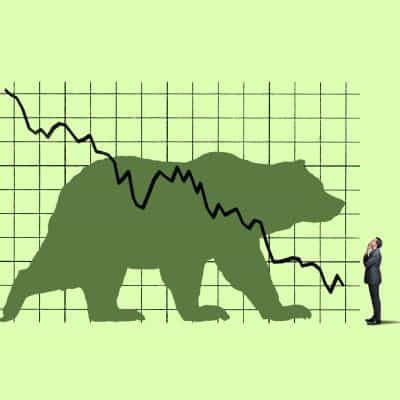
For those new to stock investing, the term “short selling” is one that has likely caused a deal of confusion. You probably understand that it is a contrarian type of investment in stocks, but how exactly does short selling work? How do short sellers drive the price down?
Short sellers drive the price of stocks down by introducing a huge number of shares to the market. This causes supply to exceed demand for that share of stock, which contributes to downward price pressure.
If this process is still a bit unclear, fear not. It takes most investors some time to understand the economics behind short selling. Keep reading as we break down short selling step-by-step to show you how it works to drive prices lower!
How Do Short Sellers Drive the Price of a Stock Down?

Short sellers drive the price of a stock down by introducing a surplus of supply into the market. As we know from Economics 101, when supply exceeds demand, the price will drop.
If you are new to the stock market or don’t naturally think like an economist and none of this makes sense to you, it can be helpful to answer the question “What is short selling?” by using a product everyone is familiar with: eggs.
If you have been to the grocery store recently you know that the price of eggs has surged.
The price has skyrocketed for a number of reasons. From increased freight costs to illnesses in chickens, we have been hit with a perfect storm of issues. The result is that prices keep going up. This has caused supermarket shelves to remain empty as people panic buying eggs whenever they are in stock. Demand is still exceeding supply, and the ensuing scarcity drives prices up.
But maybe you know something is about to change and you want to “short sell” the egg market. Perhaps you know for certain that people will simply stop eating eggs once they reach a certain price. Or maybe you see that freight prices will come back down to pre-inflation levels in the coming days.
A Closer Look at the Process of Shorting a Stock Using Eggs

Whatever the case, you see an opportunity to capitalize on the impending crash and want to “short” the egg market. Here’s how you would pull it off:
- You contact a supplier who agrees to “loan” you a huge quantity of eggs at the currently elevated prices
- You take these “loaned” eggs and sell them to a distributor at these elevated prices, pocketing the cash from the sell
- The market changes you foresaw arrive and combined with the huge quantity of eggs you and other short sellers have introduced to the market, the price of eggs plummets as distributors scramble to clear their shelves of inventory (supply now exceeds demand)
- When the price of eggs drops to an acceptable level, you go and buy back the “borrowed” quantity of eggs from a distributor, returning the borrowed eggs back to the original supplier
- This means you get to keep the cash difference from the elevated price at which you introduced them to the market and the low price at which you bought them back and returned them to the original supplier
Now, this is obviously a simplistic look at short selling in a market that doesn’t lend itself to short selling. Hopefully those unfamiliar with the stock market see how the concept of short selling can contribute to driving prices down.
Short sellers identify stocks they believe are overpriced. They then borrow shares from a lender at a high price and flood the market with a huge quantity of overpriced shares. This puts downward price pressure on the stock due to the effects of supply and demand.
When short sellers believe the price has bottomed, they buy back the borrowed quantity of stock. They then return these shares to the lender and keep the difference from the sell/buyback transaction.
The Effects of Short Selling on the Market and Individual Stocks?
Now that you know a little about how short sellers drive the price down, let’s take a look at the effects of short selling on individual stocks and the broader market.
The most significant effect that short selling has on a stock is that it creates negative sentiment around the stock. When traders see the flood of inventory entering the market, causing the price to drop, it can result in a chain reaction of panic selling as sentiment on stock goes from bullish to bearish. Naturally, traders will want to get what they can from their investment before prices drop any further.
This results in the stock becoming “oversold,” and supply becomes astronomical compared to demand. It can then become hard to sell the stock for pennies on the dollar, which we have seen in the widespread selloff of tech stocks in the current bear market.
The effects of short selling on the broader stock market function the same way as they do for individual stocks. The one caveat is that it is generally harder to short blue chip stocks that weigh heavily on the indexes, as it is more difficult to convince traders that the value of major names will go down for a long.
Short selling does work well for overvalued speculative stocks, but they have much less of an impact on the market than household names like Microsoft, Google, or Walmart.
How to Identify a Company That’s Being Targeted by Short Sellers?
While there is no exact science for identifying companies that are being targeted by short sellers, here are a few signs to keep an eye on:
- Stocks that have been on meteoric rises with no apparent underlying reason. This was the case with many tech stocks prior to 2022
- Companies that use a lot of debt to fund operations
- Companies that do not have a clear path to profitability
- Businesses that are killing it right now but can be easily replicated by competitors
- Elevated P/E (price-to-earnings) ratios. Anything over 30 should be a red flag, with veteran stock traders liking their companies to be close to 10
- Companies that seem to have questionable leadership
These are just a few of the warning signs of a company primed to be shorted. Really, anything that makes you believe that a company’s current success is unsustainable can be used by short sellers to enter a short trade.
The Risks and Rewards of Short Selling

The most significant upside to short selling is that it is a great way to make some big money fast. There is an old saying in the stock trading world: “Price takes the stairs up and the elevator down.” So if you time it just right, your short-selling investment can become lucrative much faster than a normal appreciation-based trade.
However, there are a couple of significant risks with short selling.
First, the earnings potential is capped with a short trade. The most you can ever make is 100% of your investment. If you buy a company at an elevated price and its price goes to zero, that is it. No more earnings for you.
While this would obviously represent a wonderful profit that no trader would balk at, the upside of a traditional trade is unlimited. Getting in at the right time for a company like Amazon, Google, Tesla, Netflix, etc. would have yielded you 1,000%+ on your initial investment, as there is no upper limit of what a stock price can reach.
This also means that if you tried to short one of these companies at the wrong time, the price at which you would have to buy shares back would be many times higher than what the profit potential of short selling could ever be.
The other thing to really think about with short selling is that you eventually have to return your shares to the lender. You can’t simply wait and hold for the price to drop like you can wait and hold for the price to appreciate in a traditional stock purchase. Those borrowed shares have to be returned, and if the price is high at the due date, you will suffer major losses.
The Bottom Line: How Short Sellers Drive Stock Price Down
Although short selling is a bit confusing for new investors, it is not too hard to grasp if you break it down in terms of simple economics.
Short sellers borrow huge quantities of shares and sell them at a high price. Then, this influx of supply creates downward price pressure on the stock.
Thanks for reading and we hope we made short selling easier to understand!
Geek, out.






![Is a Bond Considered Debt or Equity? [Quick Answer]](https://thefinancialgeek.com/wp-content/uploads/2023/01/Featured-Image-24.jpg)